
The inside
Opening the side panel reveals a nice, standard layout. Gigabyte uses the same drive latching system that we found (and liked) in the Cooler Master Centurion case. They just slide, locking the drive in place providing a truly tool-free installation of 5.25” drives. Just insert the drive into the bay, slide the locking tab and you’re done.
One unique and curious addition sits in the hard drive cage at the bottom. Gigabyte has included a tool box to keep bits in. I can’t believe how pleased I was to find this. How many times have you lost those drive rails or screws that came with your case because you couldn’t remember where you put them after initial installation? The box is secured with two screws so it is easily removed if you need the additional space for actual drives. You can fit two hard drives into the cage with the toolbox installed which should cover most users. But if you are the the type with 3-5 drives, you will want to remove it. One side note about the box, I managed to break the plastic latch that secures the lid after opening it about three times. The lid still closes with a pressure fit. Because of that and the fact that it somewhat blocks the airflow from the intake fan, I opted to just remove it.
One thing I like is to be able to remove the hard drive cage for easy installation. This cage is not coming out but the installation of hard drives is extremely easy using the included rails. As a mater of fact, you are required to use the rails so it is lucky that they work well and are easy to use.
Overall installation of all the components was very easy. Drive installation was very quick due to the convenient mounting systems. Installing the motherboard was as easy as with any other case. The 3D Aurora gives you some creative ability to route cables with strategically placed clamps and the channel struts at the top.
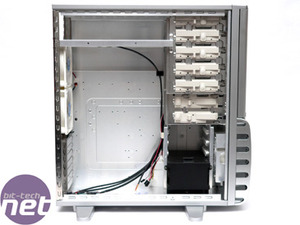
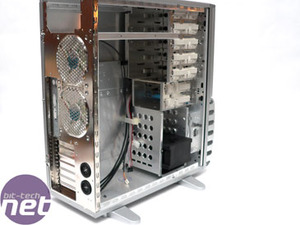
Gigabyte’s attention to detail on the 3D Aurora is impressive right down to the cable management. The two rear 120mm fans are wired together into one header and routed along the upper support strut and down through the clamp that retains all the other system wiring. You may find this sort of clean arrangement in a high end system from Alienware and the like but rarely do manufacturers take the time in a bare case.
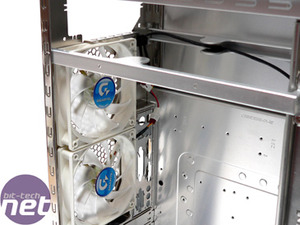
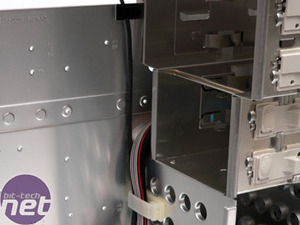
Removing the front bezel, you will find some other common and not so common elements. The circuit board for the USB, firewire, and audio is compact and clean and, more importantly, does not impede the flow of air through the front intake. A very welcome site is the removable filter (a must in any premium case IMO). A new item is the marquee underneath the fan filter. This little frame allows a graphic printed on a transparency to use the light from the LED fan to project a logo on any surface directly underneath the bezel. The standard graphic is the 3DAurora logo but there are instructions on creating your own custom/personal version. It beckons to be customized.
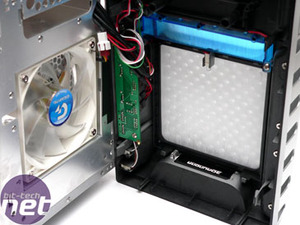
Rounding out the remaining included items are a couple Molex/SATA power adaptors and the hard drive rails I mentioned earlier. Including the SATA power adaptors is an extra touch especially considering this case does not include a power supply. That is a feature I would expect included with a power supply rather than a case. The hard drive rails are very simple. Each one has two posts that correspond with the treaded mounting holes on your hard drive. Just fit them on and slide the drive into the hard drive cage and they lock the drive into place.
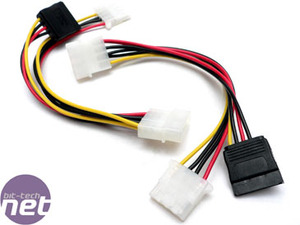
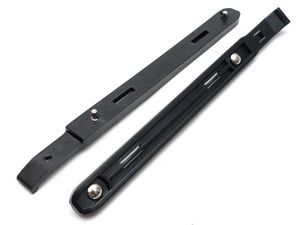
Opening the side panel reveals a nice, standard layout. Gigabyte uses the same drive latching system that we found (and liked) in the Cooler Master Centurion case. They just slide, locking the drive in place providing a truly tool-free installation of 5.25” drives. Just insert the drive into the bay, slide the locking tab and you’re done.
One unique and curious addition sits in the hard drive cage at the bottom. Gigabyte has included a tool box to keep bits in. I can’t believe how pleased I was to find this. How many times have you lost those drive rails or screws that came with your case because you couldn’t remember where you put them after initial installation? The box is secured with two screws so it is easily removed if you need the additional space for actual drives. You can fit two hard drives into the cage with the toolbox installed which should cover most users. But if you are the the type with 3-5 drives, you will want to remove it. One side note about the box, I managed to break the plastic latch that secures the lid after opening it about three times. The lid still closes with a pressure fit. Because of that and the fact that it somewhat blocks the airflow from the intake fan, I opted to just remove it.
One thing I like is to be able to remove the hard drive cage for easy installation. This cage is not coming out but the installation of hard drives is extremely easy using the included rails. As a mater of fact, you are required to use the rails so it is lucky that they work well and are easy to use.
Overall installation of all the components was very easy. Drive installation was very quick due to the convenient mounting systems. Installing the motherboard was as easy as with any other case. The 3D Aurora gives you some creative ability to route cables with strategically placed clamps and the channel struts at the top.


Gigabyte’s attention to detail on the 3D Aurora is impressive right down to the cable management. The two rear 120mm fans are wired together into one header and routed along the upper support strut and down through the clamp that retains all the other system wiring. You may find this sort of clean arrangement in a high end system from Alienware and the like but rarely do manufacturers take the time in a bare case.


Removing the front bezel, you will find some other common and not so common elements. The circuit board for the USB, firewire, and audio is compact and clean and, more importantly, does not impede the flow of air through the front intake. A very welcome site is the removable filter (a must in any premium case IMO). A new item is the marquee underneath the fan filter. This little frame allows a graphic printed on a transparency to use the light from the LED fan to project a logo on any surface directly underneath the bezel. The standard graphic is the 3DAurora logo but there are instructions on creating your own custom/personal version. It beckons to be customized.

Rounding out the remaining included items are a couple Molex/SATA power adaptors and the hard drive rails I mentioned earlier. Including the SATA power adaptors is an extra touch especially considering this case does not include a power supply. That is a feature I would expect included with a power supply rather than a case. The hard drive rails are very simple. Each one has two posts that correspond with the treaded mounting holes on your hard drive. Just fit them on and slide the drive into the hard drive cage and they lock the drive into place.



MSI MPG Velox 100R Chassis Review
October 14 2021 | 15:04








Want to comment? Please log in.